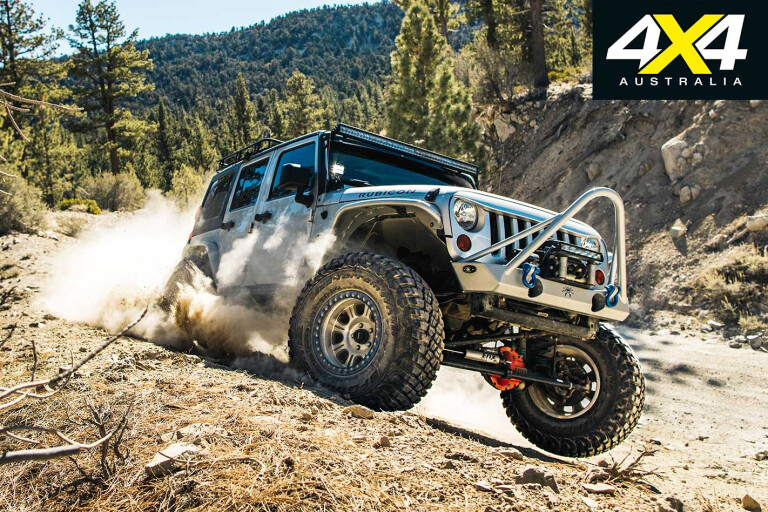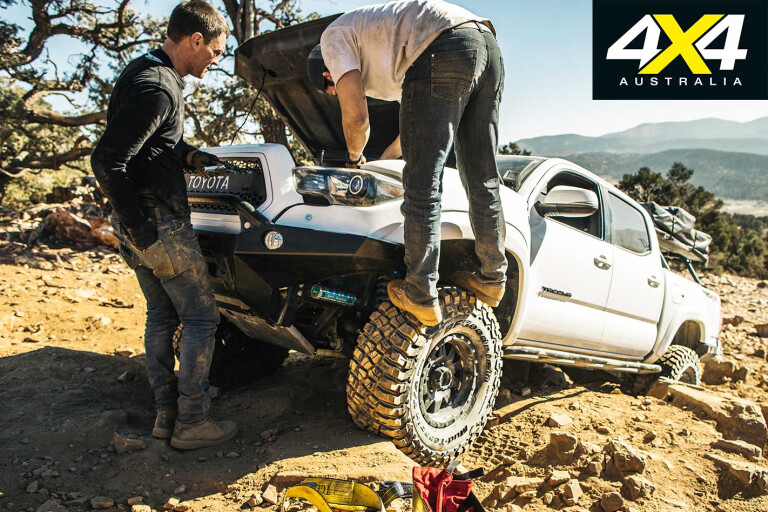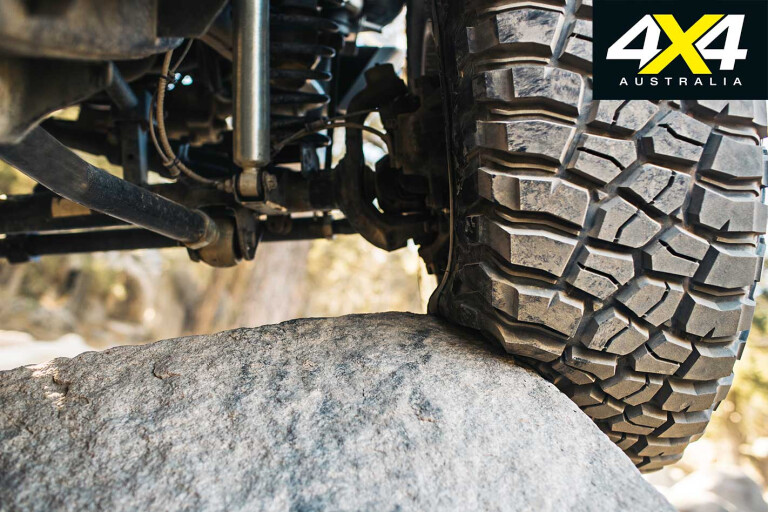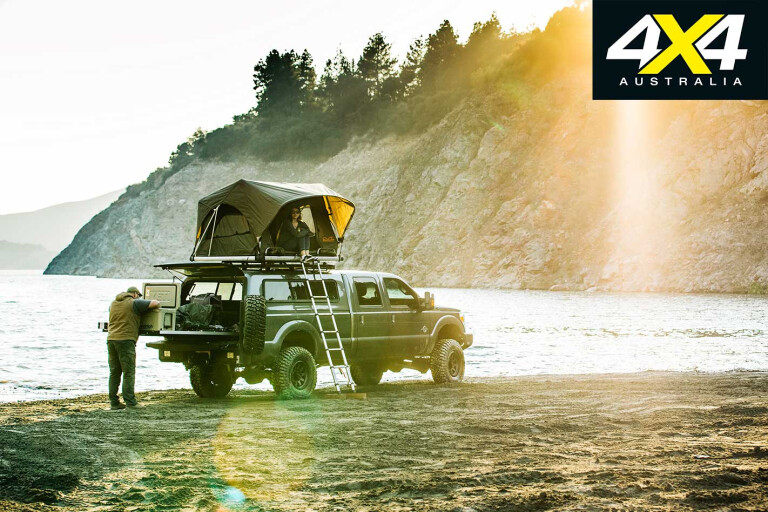
BACK in July we dissected off-road tyres, and this month one we’re taking a closer look at what lives inside that rubber: wheels.
A set of off-road wheels are an integral make-up of any serious touring machine; a good set from a respected manufacturer – wrapped with good quality rubber – ensures peace of mind when pointing your bullbar toward a crumbly climb.

But what kinds of wheels are better for off-roading? What sizes should you be looking at what? What are they made of? And what are the benefits of different compositions? We chatted to a few experts to get to the bottom of all these questions.
Upgrade your 4x4
What Should You Look For?
CRITICAL things to keep in mind when prowling the various catalogues for a new set of rims is size, construction and whether they’re load-rated to suit the GVM of your current 4x4.

Compliance to AS1638 or equivalent JWL, VIA, SAE standard is also vital, according to Glynn Helgeson, product designer for ROH Wheels. This is to ensure the wheel has survived adequate testing and is constructed correctly.
“Buy a reputable brand,” Helgeson added. “You don’t want to be stuck out in the middle of nowhere with an unusable wheel due to a slight off-road incident.”
Corey Longstreth, art director at MHT Wheels, added it’s also important to keep an eye out for exposed lug bolts, because if they get damaged, removing them could prove difficult.
Steel or Alloy?

THE differences between alloy and steel wheels are obvious from a visual perspective, but the reason alloy wheels are popular goes much deeper than simply optical appeal.
Alloy wheels are lighter, tend to be stronger and have greater heat conduction, which can be beneficial in tricky terrain. In contrast, steel wheels are heavier and don’t pack as much of a visual punch, but can be easier to repair – something of extreme importance for remote-area travellers.
Helgeson told us: “Steel wheels are inexpensive and strong, yet heavy compared to alloy wheels. Alloy wheels are lightweight, corrosion resistant and look great, but they’re more expensive than steel wheels.

Martin Tonkin, GM of Allied Wheel Group added: “Steel wheels are cheap and can be banged back into something that can get you home, but that’s about where it stops. However, they’re heavy and often not hub-centric, so vibrations are a common issue on late-model cars. They’re usually not as tough-looking as a well-styled alloy, and only as strong as the welds that hold it together.”
Tonkin was more positive when it came to alloys: “There’s an excellent range of designs and offsets. If a reputable high-load brand is bought, the wheels will be substantially stronger. They can often be custom-drilled to more uncommon offsets or fitments, and can usually be made hub-centric.”
However, he said if an alloy gets a crack they often can’t be repaired; and they can easily be damaged on rocks. “They’re usually at two to three times the price of steel wheels,” he added.
Risks of Buying Online

PICKING up a set of wheels from an unknown website might save you time and money, but there are reasons why you should avoid purchasing from companies that lack a reputation in the industry.
The most important reason is that buying from a reputable brand means you’ll get a factory-backed warranty – as opposed to a lack of product liability from some online eBay sellers – and adequate customer support and service.
“Be aware of ‘no-name’ brands online,” Tonkin said. “These are usually imported by smaller companies looking for a quick buck. You can still buy trusted-name wheels on eBay, but make sure you check that the seller understands your vehicle’s offset and specific needs, particularly if you are unsure yourself.”
“The wheels might be cheaper, however there is a greater possibility of fake wheels, copies and wheels which aren’t tested adequately,” Helgeson added. “Again, you don’t want to be stuck out in the middle of nowhere with a cracked or bent wheel.”

MHT’s Longstreth reiterated that point: “When buying any wheel it’s important to know it’s been manufactured and approved to the standards of the country it’s being driven in.”
“Not having proper certification can cause legal issues and in extreme cases could potentially expose to potential for failure.”
Size Matters

WHEEL SIZES in the off-road world typically range from 15 to 20 inches, but the larger the diameter the more impractical they become when tarmac turns to dust and eventually mud.
“Multiple sizes are available,” Helgeson said. “However, 16- and 17-inch are the most common off-road sizes due to being able to maximise the sidewall of the tyre to absorb impact and shock.”
A bigger sidewall tyre affords more protection for the rim, which, as mentioned previously, is possible due to the size of the rim itself, as Tonkin explained.

“Smaller diameter wheels allow a bigger sidewall tyre, and hence can protect the rim more from a hit from the tyre’s sidewall profile. Lower profile tyres have less of a sidewall and can mean the wheel is less protected and more prone to copping the full force of a hit directly to the wheel.”
Longstreth says that there are other things to keep in mind when opting for smaller diameter wheels: “Smaller diameter wheels can allow you to run a larger tyre, which, in-turn, can have the ability to create a larger contact patch; but, at the same time, it might have a rotational weight penalty from the additional rubber. Smaller wheels severely limit brake sizes.”
But how do you decide what’s best? Well, the choice is dictated by tyre size and OEM wheel size limitations.

“Wheel size is now dictated by tyre choice and OEM wheel size limitations,” Helgeson says. “17-inch now has the greatest variety of tyre choices; what to pick depends on what terrain you will cover, i.e. sand, rocks, mud, etc."
“Off-roading on 18-inch or 20-inch wheels is probably not the best idea as you’ll feel every bump, however good 18-inch off-road tyres are now readily available for vehicles which cannot downsize due to a large OEM wheel size,” he added.
However, it’s important to remember that consumers will run into clearance issues when they increase a tyre’s diameter and lower the offset. “This is why it’s recommended as you increase size to also lift the vehicle,” Longstreth explained.

“As you increase the diameter of a wheel you can, at the same time, limit the tyre sidewall size you can run. If your vehicle is lifted and can fit a 33-inch tyre, going from a 15, to 16, to 17 (and up) limits sidewall selection. This can have an adverse effect on ride quality as well as the ability for the tyre to flex over objects.”
Another thing to look out for is wheel poke, as in, how much the wheel sticks out. “The more ‘poke’ on your wheels potentially can mean you will graze them against things if outside the line of your cars body,” Tonkin says. “Then again, wider fitments can give stability and allow for a larger footprint on the dirt.”
Numbers Game

WHAT do those numbers on a wheel mean? Well, using 17 x 8.5 6/139 P7 as an example, the first number is the wheel diameter in inches (so 17 inches); the second number indicates the wheel width in inches (in this case, 8.5 inches). We’ve covered the importance of a wheel’s diameter, but the wheel’s width is important because the wider the wheel, the more horizontal grip will be provided.
The next number (6) indicates the number of wheel studs, followed by the Pitch Circle Diameter (139), which is the diameter, in millimetres, of the circle which passes through the centre of all the studs, wheel bolts or wheel rim holes.
The next digits (P7) explain the offset of the wheel, from the hub mounting surface to the centre of the wheel. Also measured in millimetres, the wheel offset results in a positive, negative or zero offset – in this case, positive 7mm.
Beadlocked & Loaded

“DEPENDING on the degree to which one is involved with off-roading, things like true beadlocks can aid in the ability to traverse difficult terrain at lower tyre pressures without de-beading the wheel accidentally,” Longstreth told us.
A beadlock is a device typically used in competitive and extreme off-roading to secure the bead of a tyre to the wheel of a vehicle. It’s so that in situations where a tyre’s low pressure can’t hold the bead of a tyre, the beadlock will keep the two rotating together. Typically you’ll find it’s a ring with bolts clamping the wheel and tyre together.
“A beadlock is designed to be used to hold the tyre on the wheel, when low pressures are being run on your wheels. The ring is designed to hold tyre on so it doesn’t roll off the rim,” Tonkin said. “Low pressures increase surface area of the tyre for traction in the dirt. It’s not really necessary on most applications, it will just mean pressures can be down as low as 1-5 psi for extra bag.”

They might look the bee’s knees beneath your decked-out tourer, but it’s important to remember that they aren’t legal for road use in Australia.
“Beadlock wheels are strictly for off-road use only and not legal for road use in Australia,” Helgeson told us.
Across the ditch in the USA, Longstreth confirmed that certifying beadlocks for street use is also not possible as there’s currently no federally approved method for testing.
Why are they illegal? Well, safety reasons mainly, as problems could arise from interfering with the structural rigidity of the vehicle.

However, Longstreth reckons times are changing: “The old fear and misconception that beadlocks don’t balance well or tend to leak comes from an era where manufacturing technology and economies of scale simply didn’t apply,” he said.
“Too many makers of old beadlocks were simply cutting apart wheels and welding in new parts. This method was, at best, mildly accurate. With the invention of tighter manufacturing tolerances for OE and non-OE parts and automated machines, manufacturers can (now) build wheels that meet most applicable standards.”
Load Ratings

“A wheel load rating is the mass the vehicle must support on that corner of the vehicle, sometimes referred to as axle loading,” explained Helgeson.
“In theory, the mass distribution should be equal at all four corners of the vehicle – i.e. 50:50 mass distribution, so each wheel would need to carry 25 per cent of the total GVM,” he said. “However, mass distribution in 4x4 vehicles may have a 60:40 split, so the rear wheels may need to carry more load than the front wheels.
“To account for this we calculate the required wheel loading by multiplying the GVM x 0.3 which allows for a 60 per cent loading on one axle.”

Helgeson added that this is a rule of thumb and should be calculated accordingly if you have heavily modified your vehicle.
The consequences of not adhering to load ratings go beyond voiding your insurance or having a car that’s no longer roadworthy. Having an overloaded vehicle with wheels that aren’t load-rated to suit can put your life at risk, as well as others on the road.
“Consumers should be looking at the wheels load rating if specifically buying the wheels for off-road use,” said Allied’s Martin Tonkin. “A high load rating will help when putting your wheels through some serious 4x4 driving.”

MHT’s Corey Longstreth explained to us that a wheel’s load rating should not be exceed by a vehicle’s heaviest gross axle weight, divided in half.
“For example, if your vehicle’s heaviest axle weight is 4000lbs and the wheel you’ve selected has a load rating of 1500lbs, then you have exceeded the load the wheel can carry by 500lbs,” he said. “While this might not mean immediate failure of the wheel, it can lead to a potentially catastrophic failure of the wheel that could have fatal results."
“Manufacturers will tell you to never exceed the load rating because extensive FEA analysis has determined that number is the maximum load the wheel can support failure of the wheel could occur and that could potentially create an accident on the roadway.
“If the failure of the wheel is determined to be the cause by police or insurance inspectors, denial of insurance claims could occur as well as any potential legal issues associated with the accident.”
4X4 Australia's project builds
Product Offerings
ROH WHEELS
 ROH has a range of off-road wheels in its showroom – Beadlock, Vapour, Assassin, Redback Assassin, Patriot, Trojan, Octagon, Terrain, RTX, RTX LC100/200 and Impact – in a variety of sizes and finishes. ROH offers a lifetime structural warranty, three-year painted finish and one-year accessories warranty.
ROH has a range of off-road wheels in its showroom – Beadlock, Vapour, Assassin, Redback Assassin, Patriot, Trojan, Octagon, Terrain, RTX, RTX LC100/200 and Impact – in a variety of sizes and finishes. ROH offers a lifetime structural warranty, three-year painted finish and one-year accessories warranty.
Website: www.roh.com.au
ALLIED WHEELS
Allied Wheels stocks a massive catalogue of 4x4 wheels in different styles and sizes – Brute, Byron, Goanna, Jet, Kakadu and Savanna, to name a few. For warranty information, contact Allied or visit a distributor.
Website: www.alliedwheels.com.au
MHT WHEELS
 The American-based company has a catalogue overflowing with quality off-road wheels. There are plenty of dealers Australia-wide that can help you fit a set to your 4x4. MHT’s warranty guidelines say: “Under normal and reasonable use, wheels produced by MHT Wheels are warranted against defect in workmanship or materials to the ORIGINAL owner/purchaser for a period of one year from the date of purchase.”
The American-based company has a catalogue overflowing with quality off-road wheels. There are plenty of dealers Australia-wide that can help you fit a set to your 4x4. MHT’s warranty guidelines say: “Under normal and reasonable use, wheels produced by MHT Wheels are warranted against defect in workmanship or materials to the ORIGINAL owner/purchaser for a period of one year from the date of purchase.”
Website: www.mhtwheels.com















COMMENTS